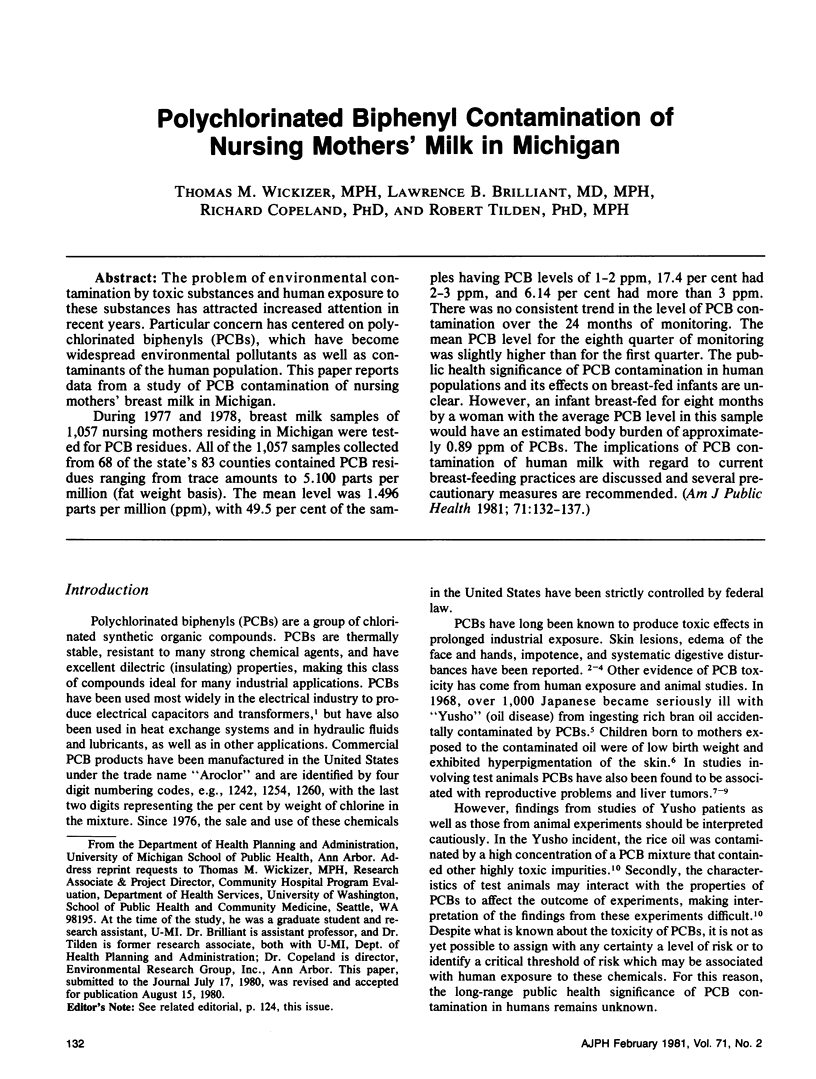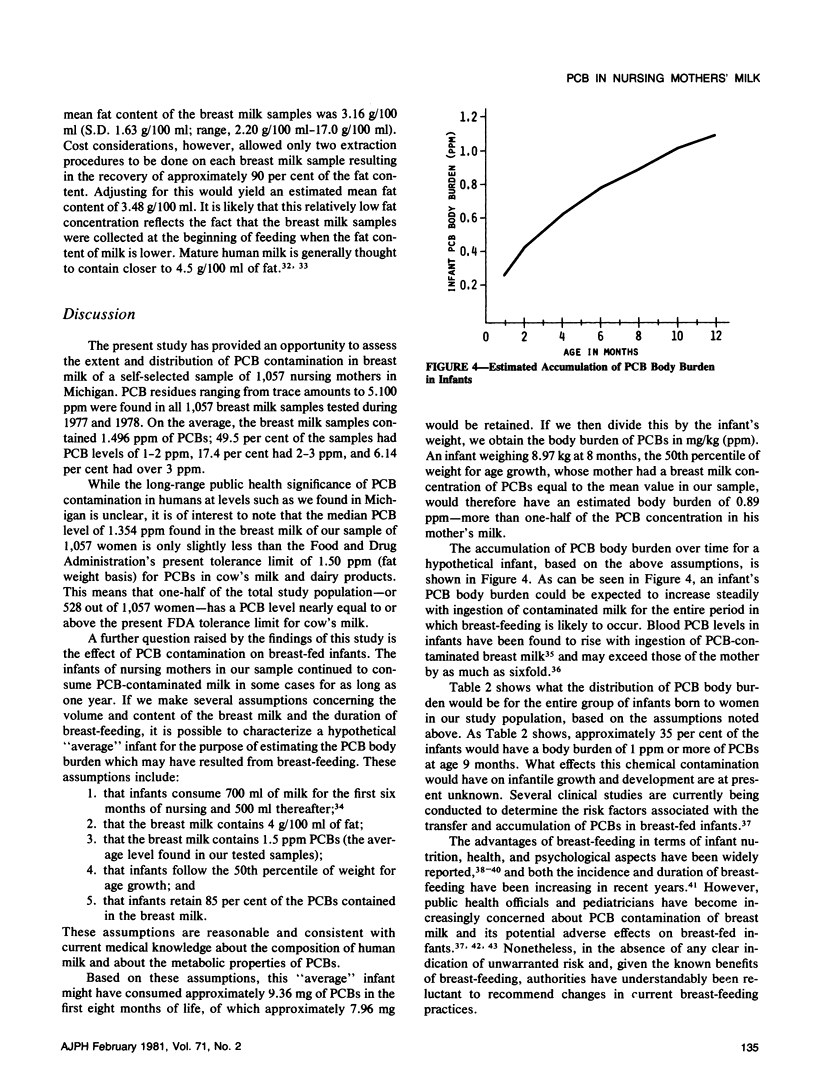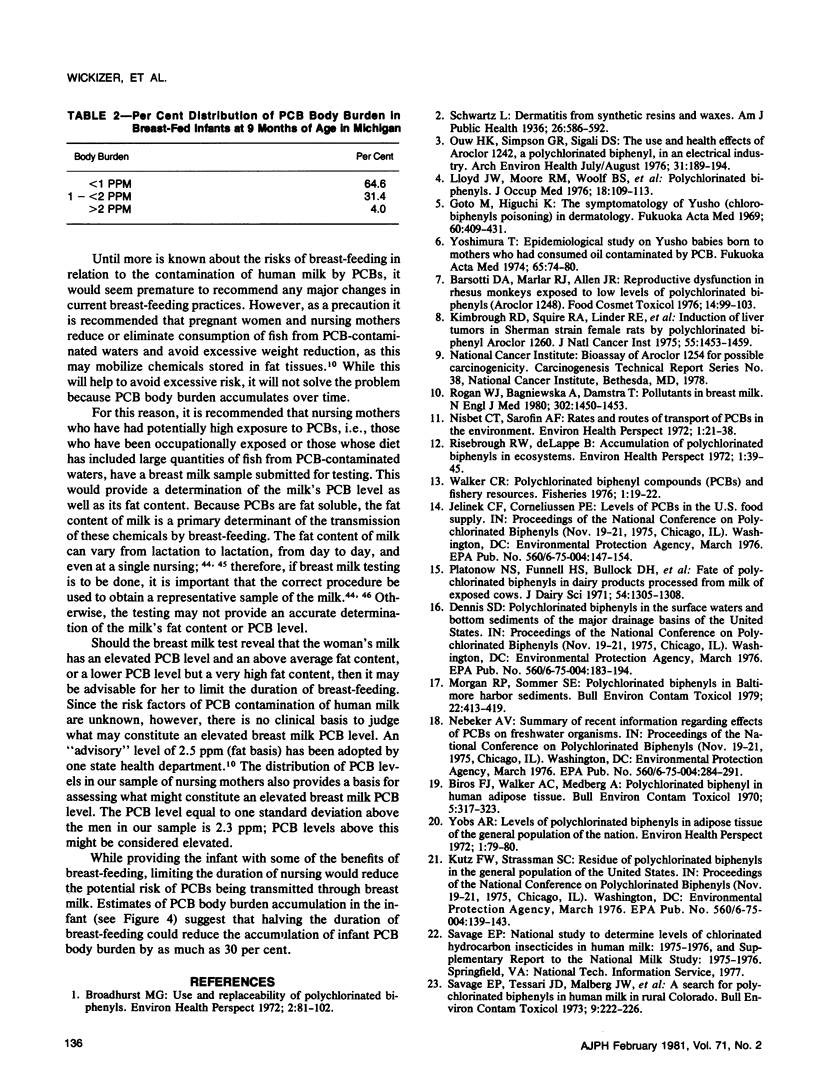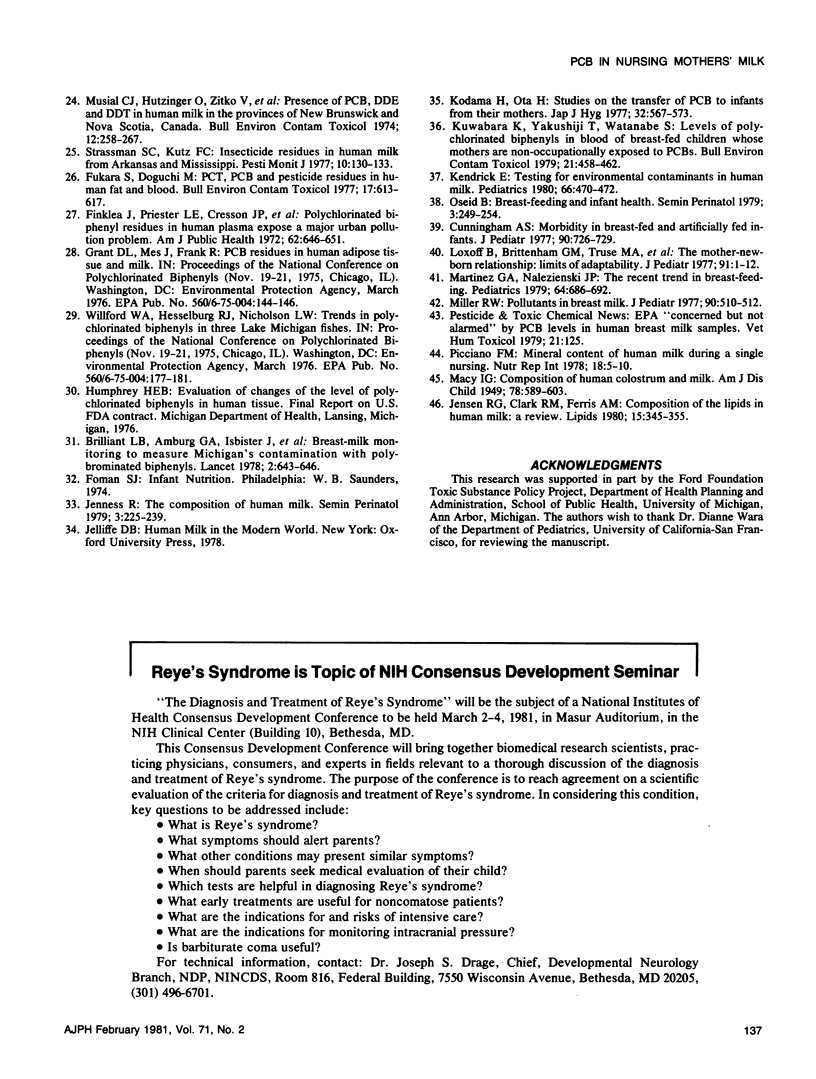Abstract
The problem of environmental contamination by toxic substances and human exposure to these substances has attracted increased attention in recent years. Particular concern has centered on polychlorinated biphenyls (PCBs), which have become widespread environmental pollutants as well as contaminants of the human population. This paper reports data from a study of PCB contamination of nursing mothers' breast milk in Michigan. During 1977 and 1978, breast milk samples of 1,057 nursing mothers residing in Michigan were tested for PCB residues. All of the 1,057 samples collected from 68 of the state's 83 counties contained PCB residues ranging from trace amounts to 5,100 parts per million (fat weight basis). The mean level was 1,496 parts per million (ppm), with 49.5 per cent of the samples having PCB levels of 1-2 ppm, 17.4 per cent had 2-3 ppm, and 6.14 per cent had more than 3 ppm. There was no consistent trend in the level of PCB contamination over the 24 months of monitoring. The mean PCB level for the eighth quarter of monitoring was slightly higher than for the first quarter. The public health significance of PCB contamination in human populations and its effects on breast-fed for eight months by a woman with the average PCB level in this sample would have an estimated body burden of approximately 0.89 ppm of PCBs. The implications of PCB contamination of human milk with regard to current breast-feeding practices are discussed and several precautionary measures are recommended.
Full text
PDF





Selected References
These references are in PubMed. This may not be the complete list of references from this article.
- Barsotti D. A., Marlar R. J., Allen J. R. Reproductive dysfunction in rhesus monkeys exposed to low levels of polychlorinated biphenyls (Aoroclor 1248). Food Cosmet Toxicol. 1976 Apr;14(2):99–103. doi: 10.1016/s0015-6264(76)80251-9. [DOI] [PubMed] [Google Scholar]
- Brilliant L. B., Wilcox K., Van Amburg G., Eyster J., Isbister J., Bloomer A. W., Humphrey H., Price H. Breast-milk monitoring to measure Michigan's contamination with polybrominated biphenyls. Lancet. 1978 Sep 23;2(8091):643–646. doi: 10.1016/s0140-6736(78)92758-7. [DOI] [PubMed] [Google Scholar]
- Broadhurst M. G. Use and replaceability of polychlorinated biphenyls. Environ Health Perspect. 1972 Oct;2:81–102. doi: 10.1289/ehp.720281. [DOI] [PMC free article] [PubMed] [Google Scholar]
- Cunningham A. S. Morbidity in breast-fed and artificially fed infants. J Pediatr. 1977 May;90(5):726–729. doi: 10.1016/s0022-3476(77)81236-5. [DOI] [PubMed] [Google Scholar]
- Finklea J., Priester L. E., Creason J. P., Hauser T., Hinners T., Hammer D. I. Polychlorinated biphenyl residues in human plasma expose a major urban pollution problem. Am J Public Health. 1972 May;62(5):645–651. doi: 10.2105/ajph.62.5.645. [DOI] [PMC free article] [PubMed] [Google Scholar]
- Fukano S., Doguchi M. PCT, PCB and pesticide residues in human fat and blood. Bull Environ Contam Toxicol. 1977 May;17(5):613–617. doi: 10.1007/BF01685986. [DOI] [PubMed] [Google Scholar]
- Jenness R. The composition of human milk. Semin Perinatol. 1979 Jul;3(3):225–239. [PubMed] [Google Scholar]
- Jensen R. G., Clark R. M., Ferris A. M. Composition of the lipids in human milk: a review. Lipids. 1980 May;15(5):345–355. doi: 10.1007/BF02533550. [DOI] [PubMed] [Google Scholar]
- Kendrick E. Testing for environmental contaminants in human milk. Pediatrics. 1980 Sep;66(3):470–472. [PubMed] [Google Scholar]
- Kimbrough R. D., Squire R. A., Linder R. E., Strandberg J. D., Montalli R. J., Burse V. W. Induction of liver tumor in Sherman strain female rats by polychlorinated biphenyl aroclor 1260. J Natl Cancer Inst. 1975 Dec;55(6):1453–1459. doi: 10.1093/jnci/55.6.1453. [DOI] [PubMed] [Google Scholar]
- Kodama H., Ota H. [Studies on the transfer of PCB to infants from their mothers (1) (author's transl)]. Nihon Eiseigaku Zasshi. 1977 Oct;32(4):567–573. [PubMed] [Google Scholar]
- Kuwabara K., Yakushiji T., Watanabe I., Yoshida S., Koyama K., Kunita N. Levels of polychlorinated biphenyls in blood of breast-fed children whose mothers are non-occupationally exposed to PCBs. Bull Environ Contam Toxicol. 1979 Mar;21(4-5):458–462. doi: 10.1007/BF01685453. [DOI] [PubMed] [Google Scholar]
- Lloyd J. W., Moore R. M., Jr, Woolf B. S., Stein H. P. Polychlorinated biphenyls. J Occup Med. 1976 Feb;18(2):109–113. [PubMed] [Google Scholar]
- Lozoff B., Brittenham G. M., Trause M. A., Kennell J. H., Klaus M. H. The mother-newborn relationship: limits of adaptability. J Pediatr. 1977 Jul;91(1):1–12. doi: 10.1016/s0022-3476(77)80433-2. [DOI] [PubMed] [Google Scholar]
- Martinez G. A., Nalezienski J. P. The recent trend in breast-feeding. Pediatrics. 1979 Nov;64(5):686–692. [PubMed] [Google Scholar]
- Miller R. W. Pollutants in breast milk: PCBs and cola-colored babies. J Pediatr. 1977 Mar;90(3):510–511. doi: 10.1016/s0022-3476(77)80752-x. [DOI] [PubMed] [Google Scholar]
- Morgan R. P., 2nd, Sommer S. E. Polychlorinated biphenyls in Baltimore Harbor sediments. Bull Environ Contam Toxicol. 1979 Jun;22(3):413–419. doi: 10.1007/BF02026964. [DOI] [PubMed] [Google Scholar]
- Musial C. J., Hutzinger O., Zitko V., Crocker J. Presence of PCB, DDE and DDT in human milk in the provinces of New Brunswick and NOVA Scotia, Canada. Bull Environ Contam Toxicol. 1974 Sep;12(3):258–267. doi: 10.1007/BF01709117. [DOI] [PubMed] [Google Scholar]
- Nisbet I. C., Sarofim A. F. Rates and Routes of Transport of PCBs in the Environment. Environ Health Perspect. 1972 Apr;1:21–38. doi: 10.1289/ehp.720121. [DOI] [PMC free article] [PubMed] [Google Scholar]
- Oseid B. Breast-feeding and infant health. Semin Perinatol. 1979 Jul;3(3):249–254. [PubMed] [Google Scholar]
- Ouw H. K., Simpson G. R., Siyali D. S. Use and health effects of Aroclor 1242, a polychlorinated biphenyl, in an electrical industry. Arch Environ Health. 1976 Jul-Aug;31(4):189–194. doi: 10.1080/00039896.1976.10667218. [DOI] [PubMed] [Google Scholar]
- Platonow N. S., Funnell H. S., Bullock D. H., Arnott D. R., Saschenbrecker P. W., Grieve D. G. Fate of polychlorinated biphenyls in dairy products processed from the milk of exposed cows. J Dairy Sci. 1971 Sep;54(9):1305–1308. doi: 10.3168/jds.S0022-0302(71)86025-3. [DOI] [PubMed] [Google Scholar]
- Risebrough R. W., De Lappe B. Accumulation of polychlorinated biphenyls in ecosystems. Environ Health Perspect. 1972 Apr;1:39–45. doi: 10.1289/ehp.720139. [DOI] [PMC free article] [PubMed] [Google Scholar]
- Rogan W. J., Bagniewska A., Damstra T. Pollutants in breast milk. N Engl J Med. 1980 Jun 26;302(26):1450–1453. doi: 10.1056/NEJM198006263022604. [DOI] [PubMed] [Google Scholar]
- Savage E. P., Tessari J. D., Malberg J. W., Wheeler H. W., Bagby J. R. A search for polychlorinated biphenyls in human milk in rural Colorado. Bull Environ Contam Toxicol. 1973 Apr;9(4):222–226. doi: 10.1007/BF01684829. [DOI] [PubMed] [Google Scholar]
- Schwartz L. Dermatitis from Synthetic Resins and Waxes. Am J Public Health Nations Health. 1936 Jun;26(6):586–592. doi: 10.2105/ajph.26.6.586. [DOI] [PMC free article] [PubMed] [Google Scholar]
- Strassman S. C., Kutz F. W. Insecticide residues in human milk from Arkansas and Mississippi, 1973-74. Pestic Monit J. 1977 Mar;10(4):130–133. [PubMed] [Google Scholar]
- Yobs A. R. Levels of polychlorinated biphenyls in adipose tissue of the general population of the nation. Environ Health Perspect. 1972 Apr;1:79–81. doi: 10.1289/ehp.720179. [DOI] [PMC free article] [PubMed] [Google Scholar]


